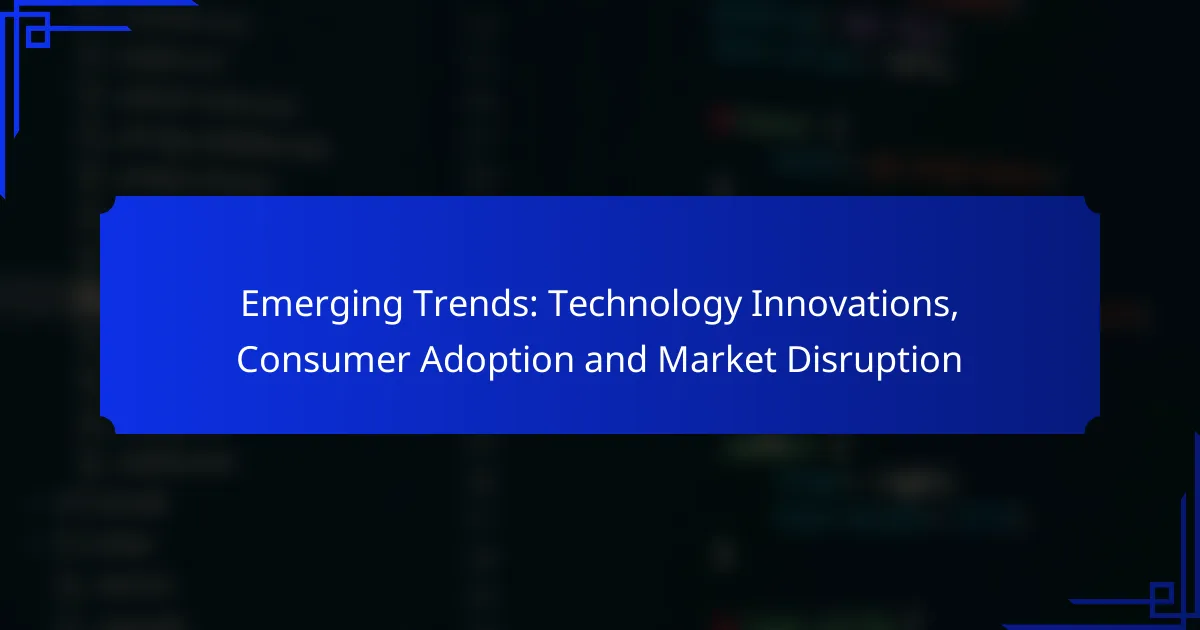The rapid pace of technology innovations is transforming industries and altering consumer behavior in profound ways. Advancements in areas such as artificial intelligence, blockchain, and the Internet of Things are not only creating new opportunities but also presenting challenges for businesses striving to keep up with evolving market dynamics. As consumers increasingly adopt these technologies for enhanced convenience and experiences, companies must adapt to stay competitive and meet changing expectations.
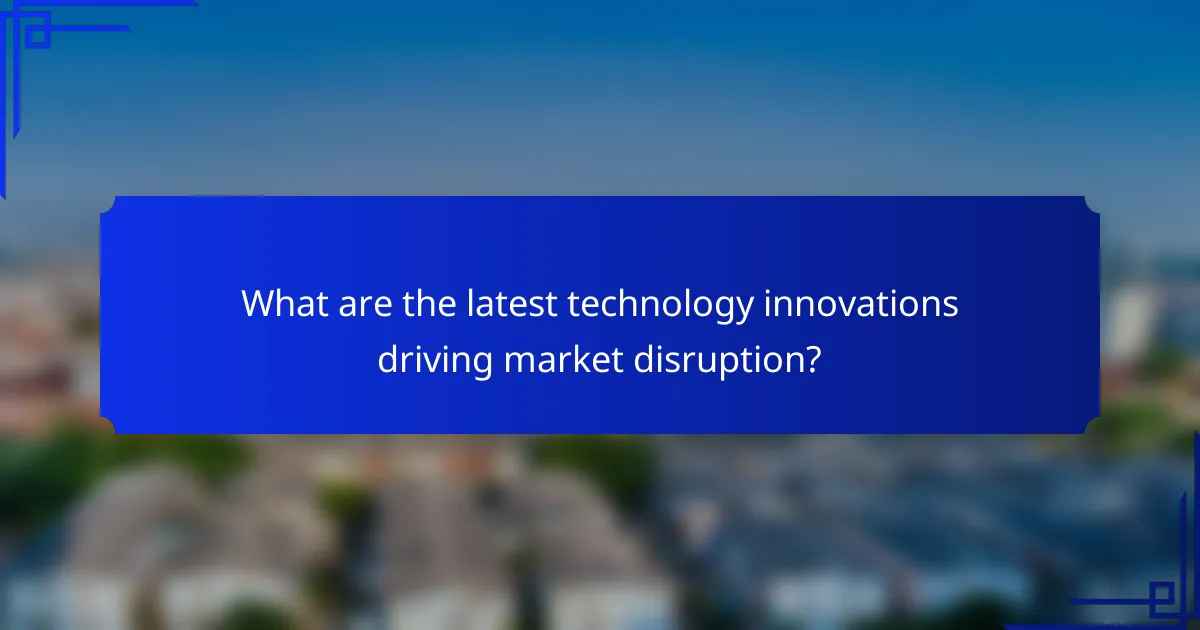
What are the latest technology innovations driving market disruption?
The latest technology innovations significantly impact various industries, reshaping consumer behavior and market dynamics. Key advancements in artificial intelligence, blockchain, 5G, IoT, and augmented reality are at the forefront of this disruption, offering new opportunities and challenges for businesses and consumers alike.
Artificial Intelligence advancements
Artificial intelligence (AI) is transforming industries by automating processes, enhancing decision-making, and personalizing consumer experiences. Innovations such as machine learning and natural language processing enable businesses to analyze vast amounts of data quickly, leading to improved efficiency and customer satisfaction.
Companies adopting AI technologies can expect to streamline operations and reduce costs. For instance, chatbots powered by AI can handle customer inquiries 24/7, freeing up human resources for more complex tasks. However, businesses must also consider ethical implications and data privacy concerns when implementing AI solutions.
Blockchain applications in finance
Blockchain technology is revolutionizing the finance sector by providing secure, transparent, and efficient transaction methods. It allows for decentralized record-keeping, which reduces the need for intermediaries and enhances trust among parties involved in financial transactions.
Financial institutions are increasingly exploring blockchain for applications such as cross-border payments, smart contracts, and digital currencies. While the potential for cost savings and increased transaction speed is significant, companies must navigate regulatory landscapes and ensure compliance with financial regulations in their respective countries.
5G technology rollout
The rollout of 5G technology is set to enhance connectivity and enable new applications across various sectors. With significantly higher speeds and lower latency compared to previous generations, 5G supports a range of innovations, from smart cities to advanced telemedicine solutions.
Businesses looking to leverage 5G should consider its implications for IoT devices and real-time data processing. However, the deployment of 5G infrastructure requires substantial investment and collaboration with telecom providers, making it crucial for companies to assess their readiness for this transition.
Internet of Things (IoT) integration
IoT integration involves connecting everyday devices to the internet, allowing for data exchange and automation. This technology is increasingly being adopted in sectors such as manufacturing, healthcare, and home automation, driving efficiency and improving user experiences.
Organizations implementing IoT solutions should focus on interoperability and security to protect sensitive data. For example, smart home devices can enhance energy efficiency, but they also require robust security measures to prevent unauthorized access. Companies must develop strategies to manage the growing number of connected devices effectively.
Augmented Reality in retail
Augmented reality (AR) is transforming the retail landscape by enhancing the shopping experience through immersive technology. Retailers are using AR to allow customers to visualize products in their environment before making a purchase, which can lead to increased sales and customer satisfaction.
For instance, furniture retailers offer AR apps that enable customers to see how a piece of furniture would look in their home. Businesses should consider investing in AR technology to differentiate themselves in a competitive market, but they must also ensure that the technology is user-friendly and accessible to their target audience.
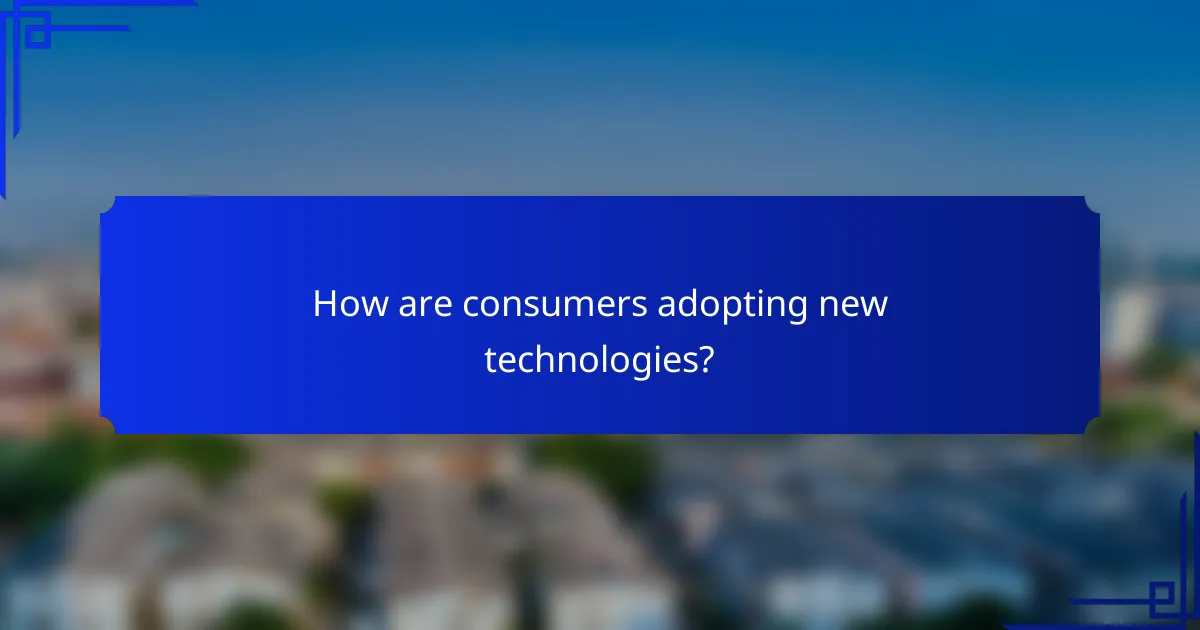
How are consumers adopting new technologies?
Consumers are increasingly embracing new technologies through various channels, driven by convenience, accessibility, and enhanced experiences. This adoption is evident across multiple sectors, reflecting changing preferences and behaviors in the marketplace.
Increased smartphone usage
Smartphones have become essential tools for daily life, with a significant portion of the population relying on them for communication, information, and entertainment. Users are now spending several hours a day on their devices, utilizing apps for everything from social networking to mobile banking.
As smartphone technology advances, features such as improved cameras, faster processors, and enhanced security measures are encouraging even more widespread adoption. Consumers should consider their needs when selecting a device, balancing performance with budget constraints.
Shift to online shopping platforms
The shift to online shopping platforms has accelerated, particularly in the wake of recent global events. Consumers appreciate the convenience of browsing and purchasing products from home, leading to a surge in e-commerce sales.
Key factors driving this trend include a wider selection of products, competitive pricing, and the ability to compare reviews easily. To maximize savings, shoppers should look for seasonal sales and utilize price comparison tools to ensure they are getting the best deals.
Growing interest in smart home devices
Smart home devices are gaining traction as consumers seek to enhance convenience and security in their living spaces. Products like smart speakers, thermostats, and security cameras are becoming more affordable and user-friendly, making them appealing options for many households.
When considering smart home technology, consumers should evaluate compatibility with existing systems and the potential for energy savings. Investing in devices that can be easily integrated into a home network can lead to a more seamless experience.
Preference for subscription services
Subscription services are increasingly popular among consumers, offering convenience and value across various sectors, including entertainment, food delivery, and software. This model allows users to access a wide range of products and services for a recurring fee, often leading to cost savings over time.
When choosing subscription services, consumers should assess their usage patterns and preferences to avoid unnecessary expenses. It’s beneficial to take advantage of free trials to determine whether a service meets individual needs before committing to a long-term subscription.
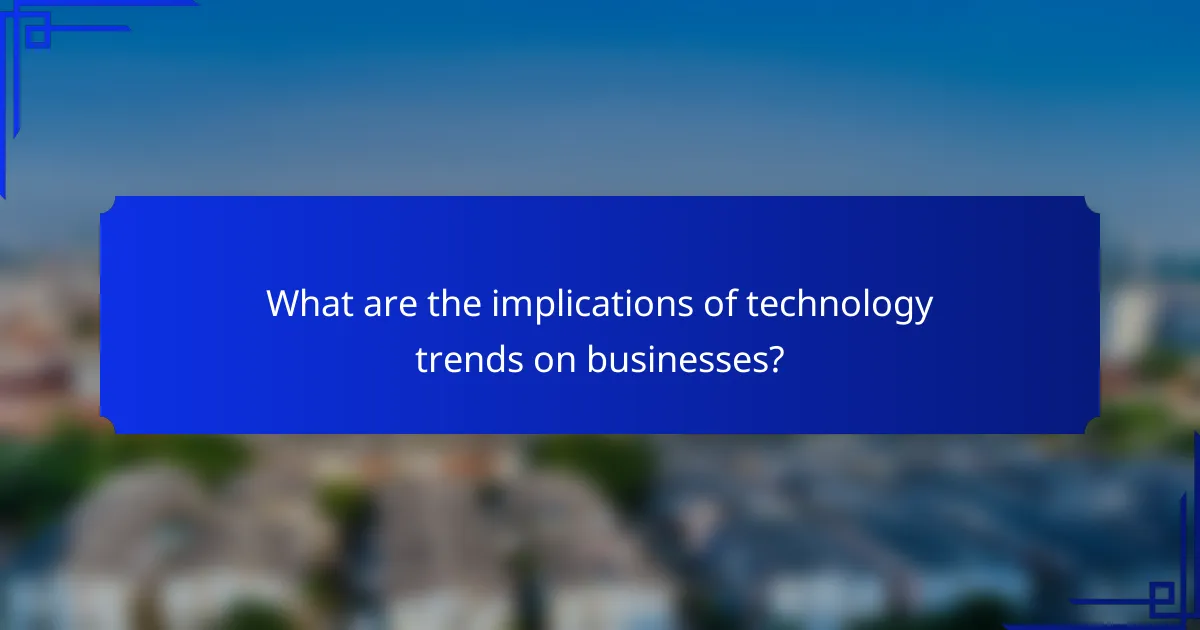
What are the implications of technology trends on businesses?
Technology trends significantly impact businesses by driving innovation, altering consumer behavior, and reshaping market dynamics. Companies must adapt to these changes to remain competitive and meet evolving customer expectations.
Need for digital transformation
The need for digital transformation has become essential for businesses aiming to thrive in a technology-driven environment. Organizations must integrate digital technologies into all areas of their operations, enhancing efficiency and customer experiences.
To effectively implement digital transformation, companies should assess their current processes, identify gaps, and prioritize technology investments. Common areas for improvement include cloud computing, data analytics, and automation tools.
Impact on customer engagement strategies
Technology trends are reshaping customer engagement strategies by enabling personalized and interactive experiences. Businesses can leverage data analytics and AI to understand customer preferences and tailor their offerings accordingly.
For instance, companies can utilize chatbots for real-time customer support or employ targeted marketing campaigns based on consumer behavior. This shift not only enhances satisfaction but also fosters brand loyalty.
Changes in supply chain management
Emerging technologies are transforming supply chain management by increasing transparency and efficiency. Businesses are adopting IoT devices and blockchain technology to track products in real-time and ensure authenticity.
Moreover, companies should consider adopting predictive analytics to anticipate demand fluctuations and optimize inventory levels. This proactive approach can reduce costs and improve service levels, ultimately leading to a more resilient supply chain.
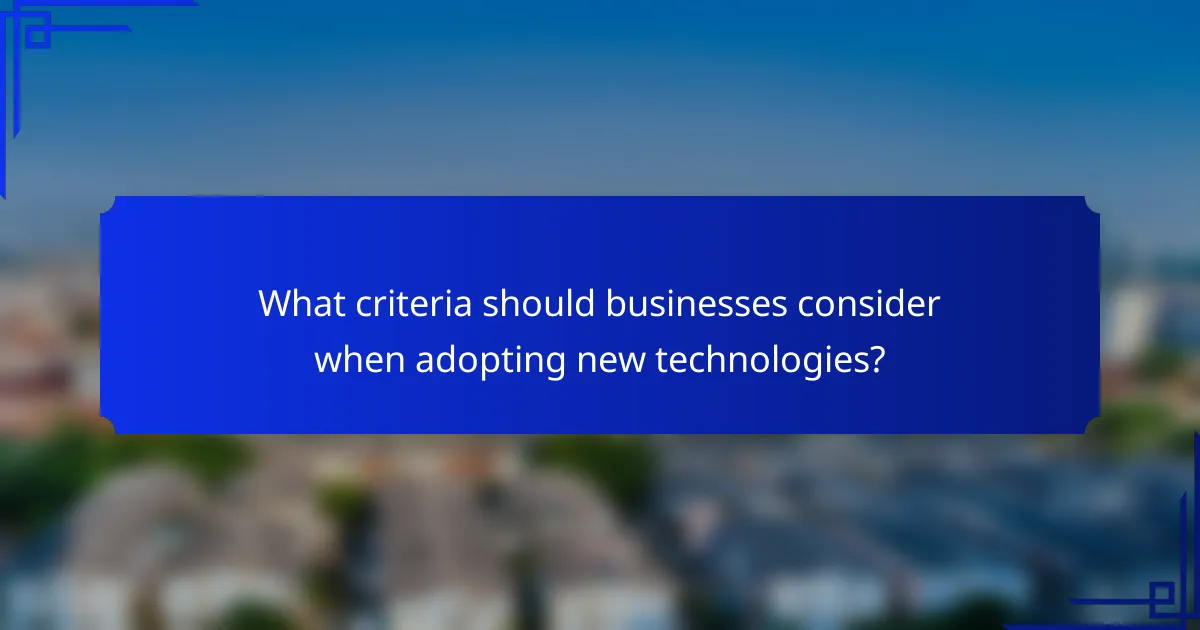
What criteria should businesses consider when adopting new technologies?
Businesses should evaluate several key criteria when adopting new technologies, including cost, scalability, and integration with existing systems. These factors help ensure that the technology aligns with the company’s goals and operational capabilities.
Cost-benefit analysis
A thorough cost-benefit analysis is essential to determine the financial viability of adopting new technology. This involves comparing the total costs—such as purchase, implementation, and maintenance—against the expected benefits, like increased efficiency or revenue growth.
Consider using a simple formula: Benefits – Costs = Net Gain. If the net gain is positive, the technology may be worth pursuing. Additionally, factor in potential risks and the time frame for realizing benefits, as these can significantly impact the overall assessment.
Scalability of solutions
Scalability refers to a technology’s ability to grow and adapt as the business expands. When assessing new solutions, consider whether they can handle increased workloads or user demands without significant additional costs or disruptions.
For example, cloud-based solutions often offer better scalability compared to on-premises systems, allowing businesses to adjust resources based on current needs. Look for technologies that provide flexible pricing models, enabling you to pay for only what you use as your requirements change.
Integration with existing systems
Successful technology adoption hinges on how well new solutions integrate with existing systems. Assess whether the new technology can seamlessly connect with current software and hardware to avoid operational disruptions.
Conduct a compatibility check to identify potential integration challenges. Consider using APIs or middleware solutions to facilitate communication between systems. Prioritize technologies that offer robust support and documentation to ease the integration process.
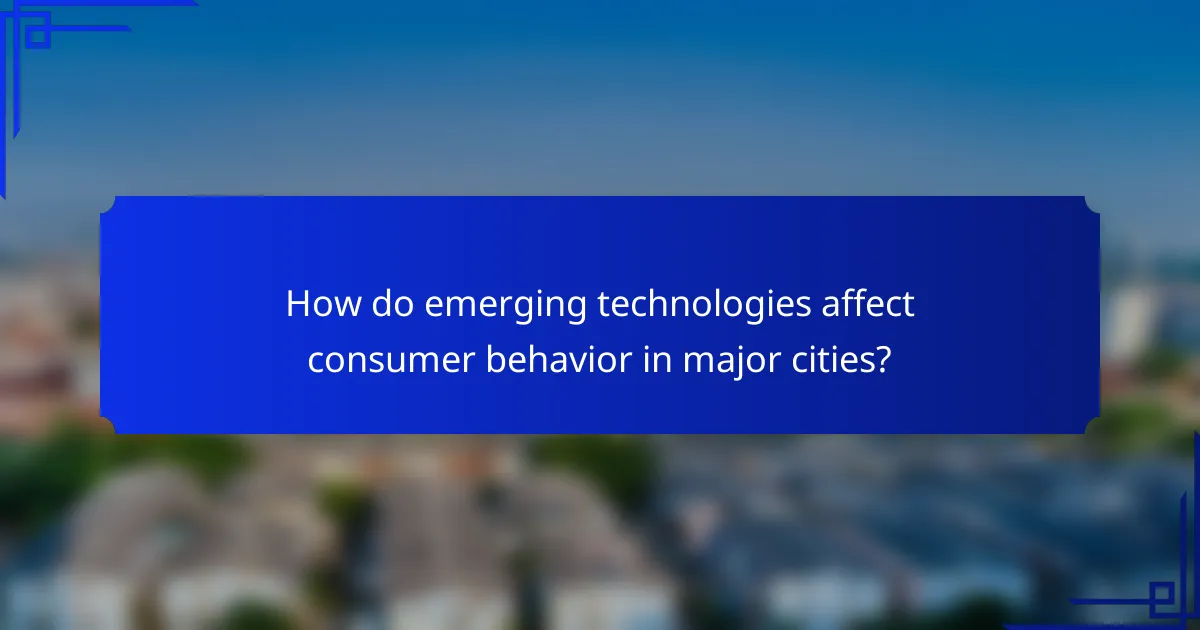
How do emerging technologies affect consumer behavior in major cities?
Emerging technologies significantly shape consumer behavior in major cities by enhancing convenience, connectivity, and access to information. As urban dwellers adopt new tech, their purchasing habits and lifestyle choices evolve, often prioritizing efficiency and digital engagement.
Urban adoption rates of smart devices
In major cities, the adoption rates of smart devices are notably high, with many households utilizing products like smart speakers, thermostats, and security systems. Surveys indicate that urban areas often see adoption rates exceeding 50% for these devices, driven by their perceived benefits in convenience and energy management.
Consumers in cities tend to favor devices that integrate seamlessly with their daily routines. For example, smart home systems that allow remote control via smartphones are particularly appealing, as they offer enhanced security and energy savings. This trend reflects a broader shift towards automation and smart living.
Influence of social media on tech trends
Social media plays a crucial role in shaping tech trends among urban consumers, acting as a platform for sharing experiences and recommendations. Influencers and tech enthusiasts often showcase the latest gadgets, driving interest and adoption among their followers.
Moreover, social media campaigns can accelerate the popularity of new technologies, with platforms like Instagram and TikTok serving as effective marketing tools. Brands that engage with consumers through interactive content and targeted ads often see higher engagement rates, leading to increased sales and brand loyalty.
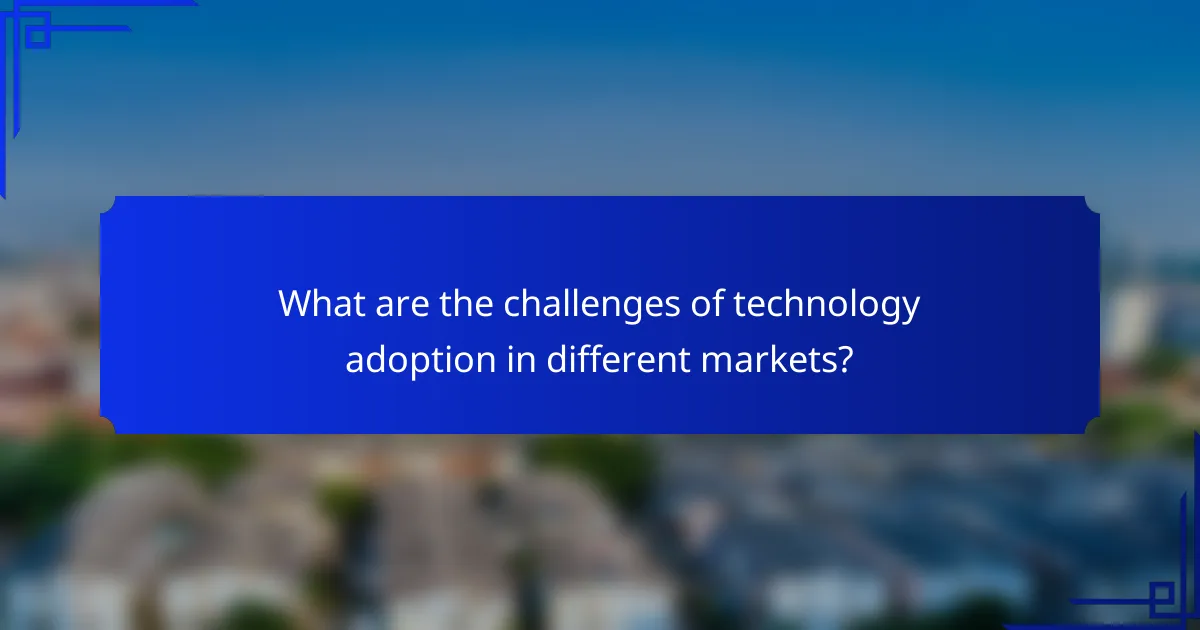
What are the challenges of technology adoption in different markets?
Technology adoption faces various challenges across different markets, primarily influenced by economic conditions, cultural attitudes, and regulatory environments. Understanding these barriers is crucial for businesses aiming to implement new technologies effectively.
Economic Barriers
Economic barriers significantly impact technology adoption, particularly in developing markets. Limited financial resources can restrict access to advanced technologies, making it difficult for businesses to invest in necessary infrastructure. For example, small enterprises may struggle to afford cloud services or high-speed internet, hindering their growth potential.
Additionally, fluctuating currencies and economic instability can deter investment in new technologies. Companies must assess the cost-benefit ratio carefully and consider phased implementations to mitigate financial risks.
Cultural Resistance
Cultural resistance can pose a substantial challenge to technology adoption. In some regions, traditional practices may conflict with modern technological solutions, leading to skepticism among consumers and businesses. For instance, industries reliant on manual labor may be hesitant to adopt automation due to fears of job loss.
To overcome cultural resistance, organizations should focus on education and awareness campaigns that highlight the benefits of technology. Engaging local stakeholders and demonstrating successful case studies can help build trust and acceptance.
Regulatory Challenges
Regulatory challenges can vary widely between markets, affecting how quickly and effectively technologies can be adopted. Compliance with local laws and regulations, such as data protection and privacy standards, is essential for businesses looking to implement new solutions. For example, the General Data Protection Regulation (GDPR) in Europe imposes strict rules on data handling that can complicate technology deployment.
Businesses should conduct thorough research on local regulations before introducing new technologies. Collaborating with legal experts can ensure compliance and help navigate potential pitfalls, ultimately facilitating smoother adoption processes.
